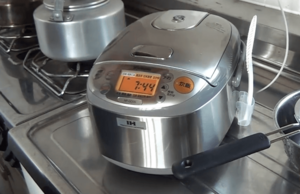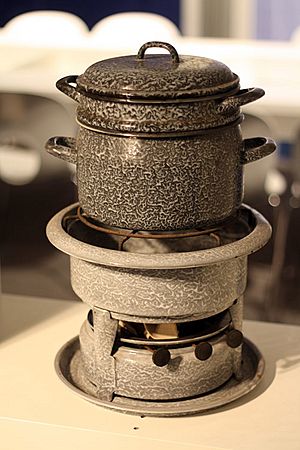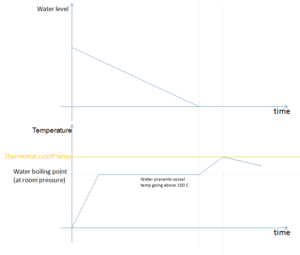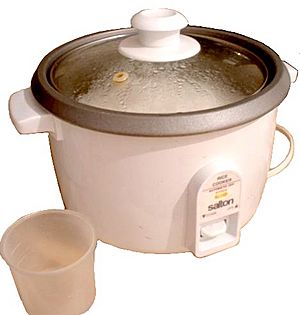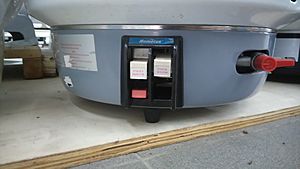Rice cooker facts for kids
A rice cooker or rice steamer is a special kitchen machine. It helps you cook rice easily by boiling or steaming it. It works automatically, so you don't have to watch it all the time.
A basic rice cooker has three main parts:
- A way to heat up the food.
- A bowl where the rice cooks.
- A thermostat, which is like a temperature sensor.
The thermostat checks how hot the cooking bowl is. It then turns the heat on or off to cook the rice perfectly. Some fancy rice cookers have even more sensors and can do many different things.
Contents
What is a Rice Cooker?
The name rice cooker used to mean simple pots for cooking rice. These pots have been around for a very long time. For example, a clay pot for steaming rice from 1250 BC is in the British Museum.
Today, the term mostly means the automatic electric machines. Electric rice cookers were first made in Japan. In Japan, they are called suihanki, which means "boil-rice-device."
How a Rice Cooker Works
A simple electric rice cooker has a main outer pot. Inside, there is a removable cooking bowl for the rice. It also has an electric heating element and a thermostat.
Here's how it cooks:
- You put rice and water into the inner bowl.
- The cooker heats the water to its boiling point (100°C or 212°F).
- The water stays at this temperature until the rice absorbs it all.
Once all the water is gone, the temperature inside the cooker starts to rise. This change tells the thermostat that the rice is cooked. Some cookers then switch to a "warming" mode. This keeps the rice warm at about 65°C (150°F). Simpler models just turn off. The rice is now ready to eat!
Advanced Rice Cookers
Some modern rice cookers are very smart. They use special technology called fuzzy logic to control the temperature even better. Instead of regular heating, some use induction heating. This makes cooking faster and more even.
Many rice cookers can do more than just cook rice. They often have:
- A steaming tray for cooking other foods.
- Settings for different types of rice, like sticky rice or porridge.
- Functions to work as a food steamer or even a slow cooker.
- Some can even bake bread or help ferment dough for bread or yogurt.
Devices that can do many things, including cooking rice, are often called "multi-cookers."
Cooking Different Rice Types
Different kinds of rice need different cooking times. For example, brown rice usually takes longer to cook than white rice. However, if brown rice is broken or specially processed, it might cook faster.
History of Rice Cookers
The first automatic electric rice cookers were made by a Japanese company called Toshiba. They released them in 1955. In December 1956, Toshiba sold the first successful automatic electric rice cookers. Since then, millions have been sold all over the world. The rice cookers we use today are quite similar to those first models.
The idea for the first useful electric rice cooker came from a person named Yoshitada Minami.
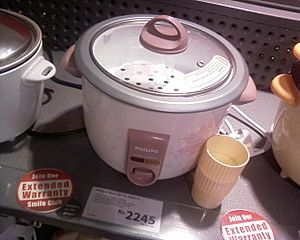
See also
In Spanish: Olla arrocera para niños


